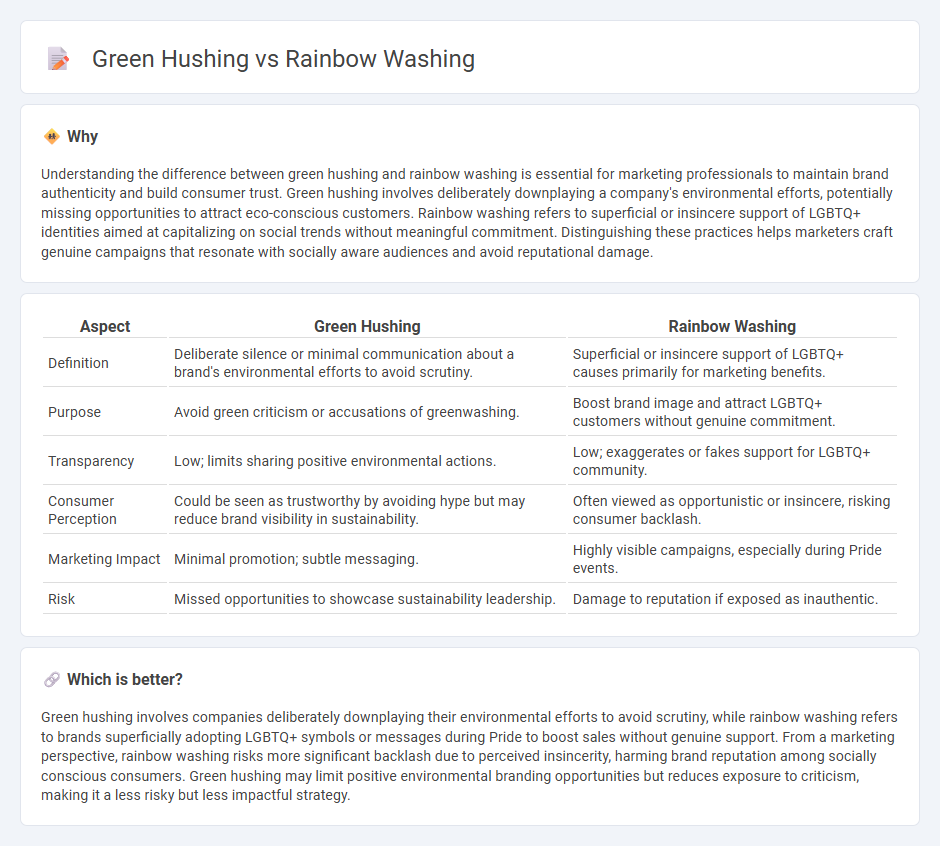
Green hushing refers to companies deliberately downplaying or hiding their environmental practices to avoid scrutiny, while rainbow washing involves brands superficially promoting LGBTQ+ support primarily for marketing gains without genuine commitment. Both tactics manipulate social issues to influence consumer perception, often eroding trust and authenticity in marketing strategies. Explore deeper insights into these practices and their impact on brand reputation and consumer behavior.
Why it is important
Understanding the difference between green hushing and rainbow washing is essential for marketing professionals to maintain brand authenticity and build consumer trust. Green hushing involves deliberately downplaying a company's environmental efforts, potentially missing opportunities to attract eco-conscious customers. Rainbow washing refers to superficial or insincere support of LGBTQ+ identities aimed at capitalizing on social trends without meaningful commitment. Distinguishing these practices helps marketers craft genuine campaigns that resonate with socially aware audiences and avoid reputational damage.
Comparison Table
| Aspect | Green Hushing | Rainbow Washing |
|---|---|---|
| Definition | Deliberate silence or minimal communication about a brand's environmental efforts to avoid scrutiny. | Superficial or insincere support of LGBTQ+ causes primarily for marketing benefits. |
| Purpose | Avoid green criticism or accusations of greenwashing. | Boost brand image and attract LGBTQ+ customers without genuine commitment. |
| Transparency | Low; limits sharing positive environmental actions. | Low; exaggerates or fakes support for LGBTQ+ community. |
| Consumer Perception | Could be seen as trustworthy by avoiding hype but may reduce brand visibility in sustainability. | Often viewed as opportunistic or insincere, risking consumer backlash. |
| Marketing Impact | Minimal promotion; subtle messaging. | Highly visible campaigns, especially during Pride events. |
| Risk | Missed opportunities to showcase sustainability leadership. | Damage to reputation if exposed as inauthentic. |
Which is better?
Green hushing involves companies deliberately downplaying their environmental efforts to avoid scrutiny, while rainbow washing refers to brands superficially adopting LGBTQ+ symbols or messages during Pride to boost sales without genuine support. From a marketing perspective, rainbow washing risks more significant backlash due to perceived insincerity, harming brand reputation among socially conscious consumers. Green hushing may limit positive environmental branding opportunities but reduces exposure to criticism, making it a less risky but less impactful strategy.
Connection
Green hushing and rainbow washing both involve the selective communication of corporate social responsibility efforts to shape public perception while managing reputational risk. Green hushing refers to companies deliberately downplaying or hiding their environmental initiatives to avoid scrutiny or accusations of greenwashing, whereas rainbow washing involves superficially promoting LGBTQ+ support without genuine commitment to diversity and inclusion. Both practices highlight the strategic manipulation of social and environmental messaging in marketing to balance authenticity with brand image management.
Key Terms
Authenticity
Rainbow washing refers to companies superficially showcasing LGBTQ+ support without genuine commitment, often solely for marketing advantage. Green hushing involves organizations deliberately underreporting or concealing environmental efforts to avoid scrutiny or backlash. Explore deeper insights into how authenticity shapes corporate social responsibility strategies.
Corporate Social Responsibility (CSR)
Rainbow washing involves companies superficially supporting LGBTQ+ causes without genuine commitment, often to boost their public image, while green hushing refers to firms deliberately underreporting or concealing their environmental initiatives to avoid scrutiny or backlash. Both practices undermine authentic Corporate Social Responsibility (CSR) by prioritizing image over impactful action and transparency. Explore how businesses can adopt sincere CSR strategies to foster trust and sustainable growth.
Brand Reputation
Rainbow washing, where brands superficially support LGBTQ+ causes without genuine commitment, can damage brand reputation through perceived insincerity. Green hushing involves companies deliberately downplaying their environmental efforts to avoid scrutiny or backlash, which may lead to consumer skepticism and reduced trust. Explore how transparent and authentic communication strategies can improve brand reputation by balancing these risks.
Source and External Links
Genuine Pride or corporate rainbow washing? - Discussion on the practice of using rainbow-themed symbolism for corporate gain without actual support for the LGBTQ+ community.
Pride Month Marketing: Why Rainbow Washing Isn't Good for Business - Explanation of how rainbow washing harms both businesses and the LGBTQ+ community by appearing disingenuous.
Rainbow Washing: What It Is and How to Avoid It - Description of rainbow washing as superficial support for the LGBTQ+ community without concrete actions, and how to avoid it.
 dowidth.com
dowidth.com